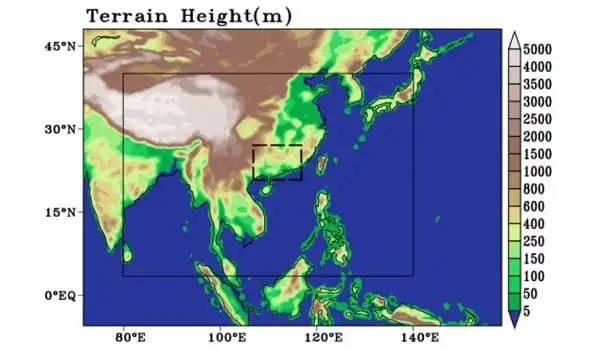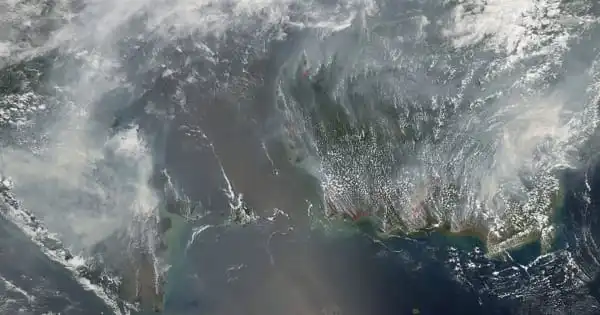During the dry season, biomass burning (BB) is especially prevalent throughout Southeast Asia. However, due to Southeast Asia’s complicated topography and long-distance transit, local study on BB pollution has been restricted. The relevance of aerosol-cloud interactions on cloud properties has been demonstrated by the fact that atmospheric aerosols from both natural and anthropogenic sources have significant effects on climate, air quality, and human health. Furthermore, climatic change can have an indirect effect on aerosol spatial distribution, which is determined by total precipitation.
Clouds have a huge impact on the Earth’s energy balance. Low clouds, such as Stratocumulus, Cumulus, and Stratus, cover around 30% of the Earth’s surface and have a net cooling influence on our climate. What mitigates global warming may have economic ramifications: a persistently dense and low cloud cover over land may affect agricultural production and solar-power generation. Understanding the causes influencing low cloud cover is crucial not only for regional weather forecasting and global climate prediction but also for understanding the socioeconomic consequences.
The impacts of aerosols on cloud formation are critical for understanding climatic forcing in the Anthropocene. Wildfires release vast amounts of biomass-burning aerosol particles into the atmosphere, which, when they combine with clouds, greatly increase the development of marine stratocumulus clouds. However, their role in areas with heavy human activity and complex monsoon circulation is unknown.
Our analysis shows that the synergetic effect of large-scale monsoon circulation and aerosol-cloud-boundary layer interactions in southeastern Asia is the main reason for the amplified aerosol effect and enhanced cloud formation.
Yafang Cheng
An international team led by Yafang Cheng of the Max Planck Institute for Chemistry (MPIC) and Aijun Ding of Nanjing University has now investigated the role of wildfires in the formation of low clouds in southern Asia, a region with a land area of about 500,000 km2 and a population of about 270 million people. The researchers took a comprehensive strategy, combining model simulations with data from meteorological observations, biomass combustion emissions, and satellites.
“We identified a very strong impact of biomass burning aerosols on cloud formation in southeastern Asia,” says Ke Ding, the study’s first author. “The degree of cloud increases over continent in this region are comparable to those in the Southeast Atlantic generated by biomass burning in Southern Africa, a well-known hotspot for wildfires, despite the fact that overall biomass burning emissions in Southeast Asia are substantially lower.” According to Ding, who was an exchange Ph.D. student in Cheng’s Group and is now an assistant professor at Nanjing University, the biomass burnin emission in this region is roughly one-fifth of that in Southern Africa.

Aerosol-radiation interactions continue to increase whereas aerosol-cloud interactions tend to saturate at high aerosol loading
“Our analysis shows that the synergetic effect of large-scale monsoon circulation and aerosol-cloud-boundary layer interactions in southeastern Asia is the main reason for the amplified aerosol effect and enhanced cloud formation,” explains Yafang Cheng, the head of a Minerva Research Group at the MPIC and the study’s corresponding author. Aerosols can either directly impact cloud formation by acting as cloud condensation nuclei (aerosol-cloud interaction) or indirectly by absorbing and reflecting solar energy (aerosol-radiation interaction).
“Despite the fact that many research have concentrated on the aerosol-cloud interaction impact, we find that the aerosol-radiation interaction effect, particularly that of absorbing soot particles, has a major role in low-cloud enhancement in Southeast Asia. This supports our recent notion that at high aerosol loading, aerosol-cloud interactions tend to saturate, whereas the strength of aerosol-radiation interactions continues to increase and plays a more essential role in highly polluted episodes and regions” The atmospheric scientist says.
The findings also show that aerosol-radiation interaction generated by biomass-burning smoke from wildfires dominates springtime low-cloud enhancement in southeastern Asia, influencing regional climate and weather. Given the direct effects of clouds over land on human activities like agricultural productivity, solar energy generation, and regional climate, the process described in this paper is critical for regional sustainability. As a result, it must be factored into future forecasting and assessment models.
Climate change is also anticipated to increase the frequency and spread of wildfires. “As a result, documenting a current-day baseline with extensive and long-term measurements, such as our ongoing project CARIBIC-SP2, can help to constrain model estimates of the climate impact of wildfire and foster our fundamental understanding of future climate change,” Yafang Cheng stated.





